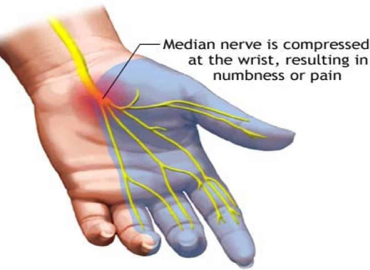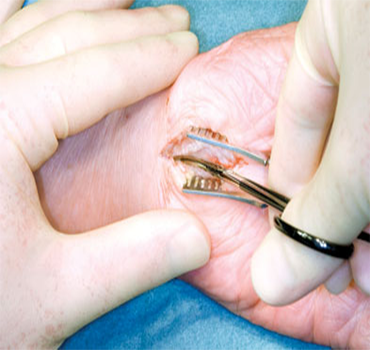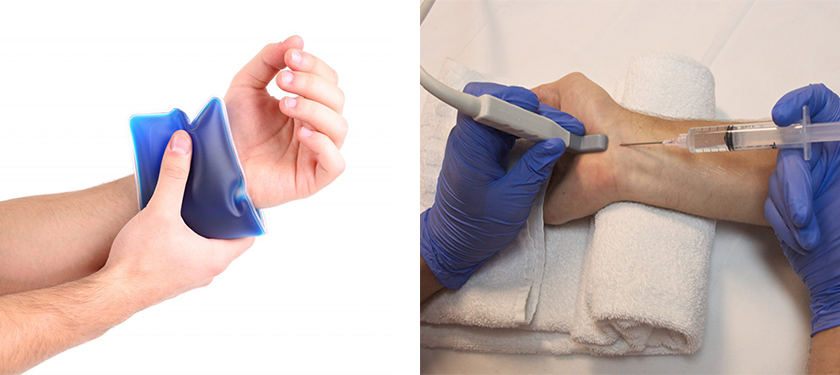Carpal Tunnel Syndrome
Home / Carpal Tunnel Syndrome
Carpal Tunnel Syndrome
Get AppointmentWhat is Carpal Tunnel Syndrome?
It is a medical condition where the median nerve, running from the forearm to the palm, is compressed.
The median nerve provides feeling to the thumb, index, middle, and ring fingers of the hand and also the signal to move the thumb muscles. The median nerve and the flexor tendons pass through the carpal tunnel at the wrist and then go into the hand. The flexor tendons help to bend the fingers and the thumb. The floor of the tunnel is made of carpal bones at the hand’s base in a ‘U’ shaped arch.
In the majority of cases, the symptoms start gradually without a specific injury. For some patients, the symptoms come and go at first and as the condition worsens, symptoms occur more frequently over time.
Causes
Several conditions can cause carpal tunnel syndrome, including diabetes, thyroid disorders, pregnancy, menopause, and arthritis.
Injuries, such as wrist fractures, and repetitive stress to the wrist, such as using a keyboard or computer mouse, can also cause carpal tunnel syndrome.
Symptoms

Carpal tunnel symptoms include:
- Weak hand muscles
- Persistent wrist pain
- Hand numbness, pain & tingling
- Progressive hand pain in the arm
If left untreated, the median nerve can become permanently damaged, resulting in increased weakness and muscle loss in the hand, as well as loss of coordination and sensation in the fingers.
Treatments
The treatment can only provide a chance to slow down or stop the progression of the disease. It is important to get evaluated and diagnosed by a doctor at an early stage.
Non-Surgical Treatment
The symptoms of Carpal Tunnel Syndrome can be relieved using non-surgical methods, provided it is diagnosed and treated in the early stages.
The different non-surgical treatment options are:
- Rest: Giving proper rest to the wrist is the first step towards recovery. The patient is recommended to stay away from any activity that can aggravate the symptoms.
- Brace: A brace is recommended by doctors to relieve the pressure on the nerve in the carpal tunnel. This can be done by wearing a brace or splint at night, helping to stop the bending of the wrist and keeping the wrist in a straight or neutral position.
- Non-Steroidal Anti-Inflammatory Drugs (NSAIDs): NSAIDs drugs like Ibuprofen etc., can help reduce pain and swelling.
- Steroid Injections: Steroid Injections like cortisone can also help as anti-inflammatory medicines and help relieve the symptoms.
- Change in Activity: The doctors would recommend changing the patient’s activity since keeping the wrist in the same position for a long time can cause the symptoms to appear. The patient can make changes in the working style or the workplace to stop and reduce the progression of the disease.
- Exercises: Doctors might recommend some exercises to help the median nerve move freely within the carpal tunnel.
Surgical Treatment
The doctors will recommend surgical treatment options if the symptoms are not relieved from non-surgical methods.
The severity of the symptoms, like the pain severity and the numbness of the hand will determine the surgery. In some cases, surgery is recommended for constant numbness and wastage of thumb muscles to prevent irreparable damage to the nerves.
The surgical procedure performed is called the Carpal Tunnel Release. In this procedure, the pressure is relieved from the median nerve by cutting the ligaments forming the roof of the tunnel, increasing the size of the tunnel, and decreasing pressure on the median nerve. The procedure is usually an outpatient procedure done under general anaesthesia or local anaesthesia of the arm.
This can be performed by two different techniques.

• Open Carpal Tunnel Release
The surgeon will create a small incision in the palm and view the inside of the wrist through this incision. The surgeon will then divide the traverse carpal ligament or carpal tunnel’s roof, increasing the size of the tunnel and relieving pressure on the median nerve.
The ligament will gradually grow back together and provide more space in the carpal tunnel.
• Endoscopic Carpal Tunnel Release
The surgeon will create a couple of portals or smaller skin incisions and uses an endoscope or small camera to view inside the wrist. A knife is then used to divide the transverse carpal ligament, and it is similar to the open Carpal Tunnel release procedure. Small scars and faster healing make this technique better.

GET APPOINTMENT
Schedule Appointment : Your Path to Specialized Care
Get rid of your pain, stress, and enduring with our 24/7 dental services. It's a priority to relieve the pain in surgeon as much as possible. 90% of customers claim that they would come back & recommend us to others.
